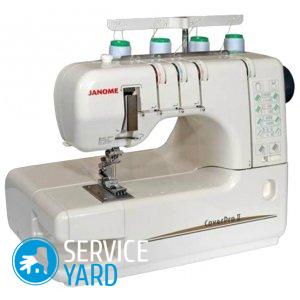How to fill overlock?

Overlock is a wonderful device that many seamstresses have appreciated. It perfectly complements the usual sewing machine. Therefore, the question of how to refill an overlock is very relevant. With the help of an overlock, you can easily process even the most difficult to process fabrics with streaming threads. However, this does not end the function of the device. Modern models allow you to sew, overcast and trim excess fabric. The resulting seams are durable and elastic. The device makes it possible to quickly and efficiently sew a braid or elastic band, to process ruffles. We will deal with all the points in more detail in order to properly use such equipment at home.
to contents ↑Important! As a rule, product processing is carried out in 3-4 threads, but individual models are also configured for two-thread processing. Five-strand models are suitable for complex products from knitted material. Naturally, you need to choose one or another option based on how often and for what kind of work you use the device.
Features of using Chinese overlock
In fact, the Chinese product is no different from the well-known Podolsk product. Rather, it is an exact copy of it, to the smallest detail. Before starting work, carefully read the instructions. It is important to follow the sequence of actions. This will avoid such trouble as a broken thread.
In many Chinese-made models, the threading algorithm is shown in the diagram on the inside of the removable cover.
Important! Sometimes, for ease of perception of information, the places where the threads are drawn are painted in different colors.
The type of thread used and the parameters of the needle depend on the type of fabric being processed. It is necessary that the thread has a free run and provides an even stitch on the fabric. To thread a thread in a Chinese overlock, special needle threader devices are often used that will help to successfully cope with the work even of a beginning seamstress.
to contents ↑Detailed instructions for refueling overlock:
- Place a working coil on the reel seat. Do not forget to fix it.
- Thread the tip of the thread through the holes or hooks of the thread guides. It is important that the bobbin holder axis is directed towards the thread guide. Only in this case, the stitch will turn out really high quality.
- Pass the thread through all the tensioning mechanisms. First, engage those that divert the thread, and then the thread-attracting ones. In separate models, the same mechanism is responsible for both functions.
- Pass the thread into the eye of the needle and then into the looper so that the movement of the material and the direction of the thread match.
- Bring the threads under the presser foot.
Helpful information
Overlock is very sensitive to the correct threading. But the quality of the stitch also depends on how well the presser presses the fabric to the teeth of the rail. With a weak pressure, the seam will turn out uneven. It is also necessary to adjust the teeth of the staff.
to contents ↑Important! The thinner the material, the lower the overlock teeth are, and vice versa.
Stock footage
Refueling modern models is a pleasure, as they are equipped with air-jet looper refills. It is enough to insert the thread into the hole, press the special lever, and the unit is already in working condition. You can not be afraid that the line will be low-quality. We hope that our instructions will be useful to you. Good luck
- How to choose a vacuum cleaner taking into account the characteristics of the house and coatings?
- What to look for when choosing a water delivery
- How to quickly create comfort at home - tips for housewives
- How to choose the perfect TV - useful tips
- What to look for when choosing blinds
- What should be running shoes?
- What useful things can you buy in a hardware store
- Iphone 11 pro max review
- Than iPhone is better than Android smartphones



